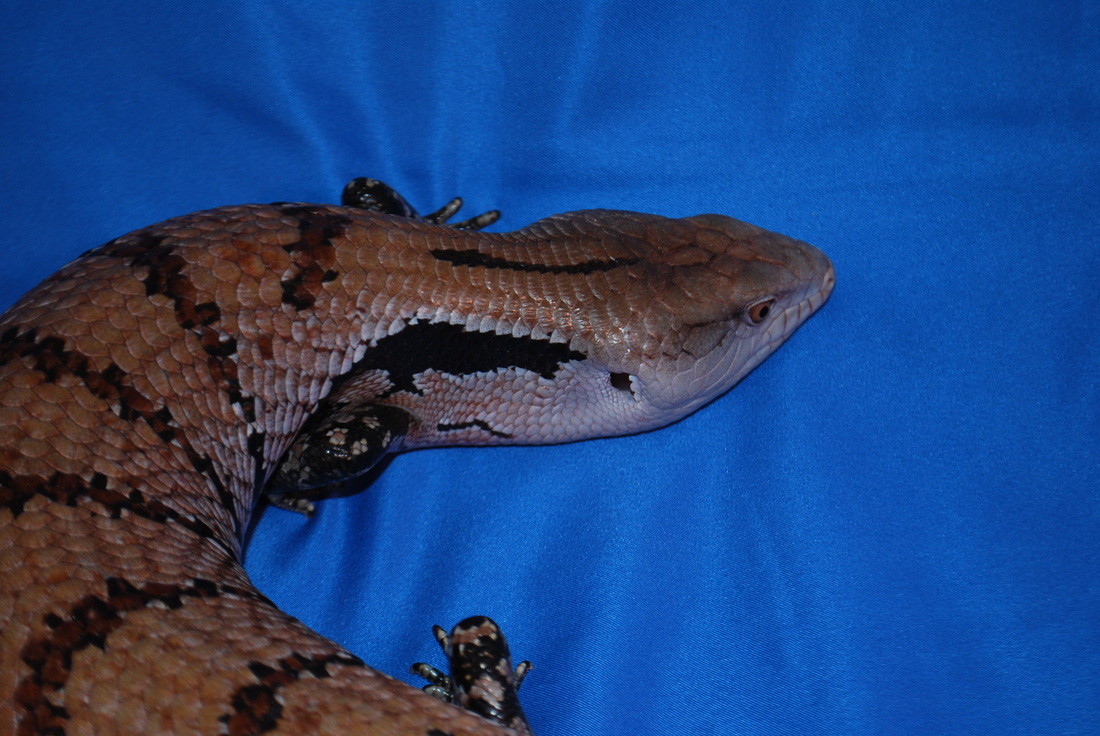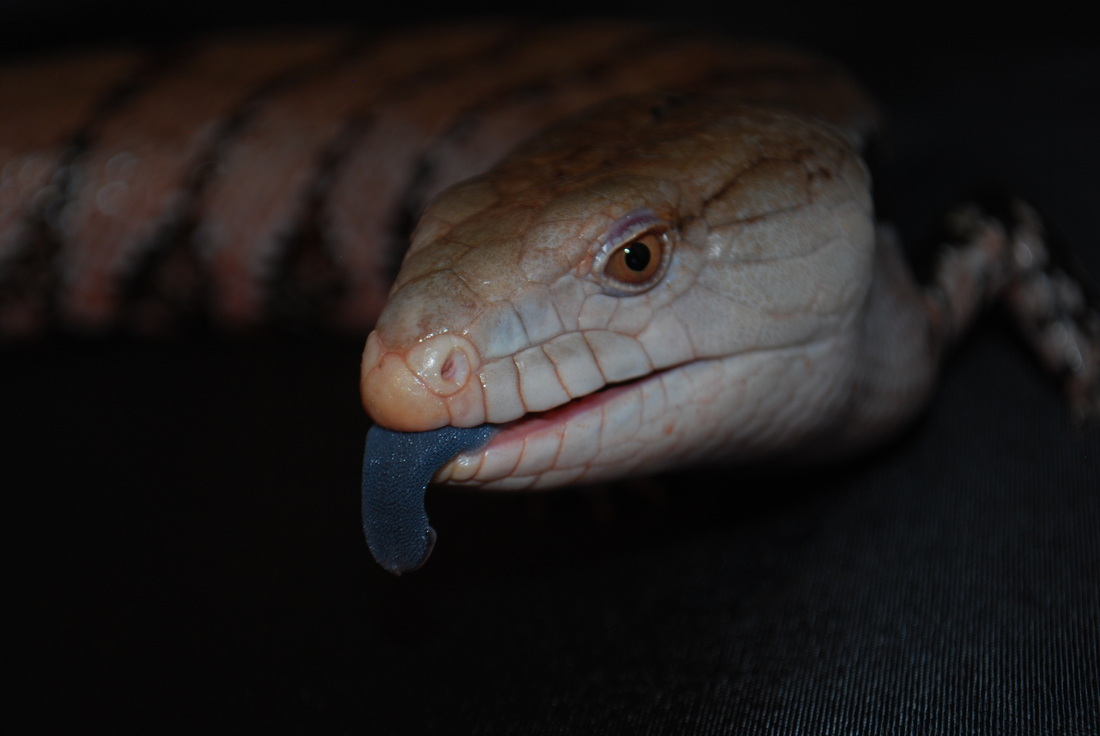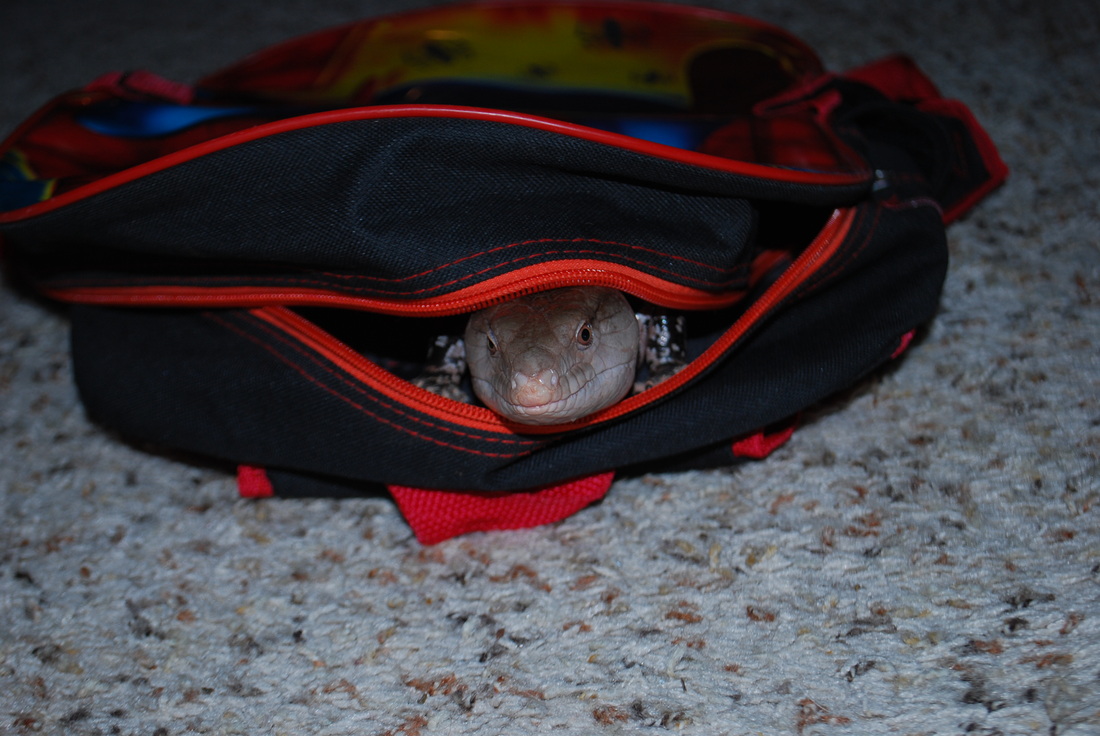PLEASE NOTE
The information on the BambooZoo site is as much as 10 years old and in the hobby much has been learned. I believe in the merit of keeping the site open and available.
These beings are as complicated as we are and deserve more than a basic 5 paragraph care sheet to maintain their health and well being. Please use BambooZoo as a beginning of your research.
Life has changed for us and my time and effort is being used to Change the World.
BLUE TONGUE SKINK CARE ~ THE BASICS
(Tiliqua gigas, Tiliqua scincoides)
Hedy S. (Barely Breathing)
Blue tongue skinks are quickly becoming very popular in the pet trade. They are medium sized, friendly lizards that are easy to house and feed. Keepers enjoy their inquisitive nature and love to show off their amazingly bright blue tongue. These are great lizards for keepers of all ages and experience levels.
Enclosure:
Blue tongue skinks can happily live out their lives in a forty gallon breeder. It’s always best to keep in mind that bigger is better. Some keepers who bring home new babies will opt to put the younger animal in a smaller enclosure, but because of how quickly these animals grow it’s best to go ahead and get them in their permanent, adult enclosure right from the start.
The substrate you choose should accommodate for their burrowing behaviors. It’s also very important to remember that some substrates are toxic, like cedar and pine. The recommended substrate for a blue tongue skink is aspen. They love to hide under it. It can be quite entertaining to watch them peak their heads out. On top of this, aspen makes clean up a breeze. I started my blue tongue off on aspen, then switched her to Eco Earth for a while. While this substrate is great for humidity and visual appeal, I noticed that she wasn’t getting anything out of it. She didn’t enjoy digging or hiding in it, so I made the switch back to aspen.
Another thing that blue tongue skinks need in their enclosures are a couple of good hides. Your skink will need at least two, one on the warm side of the enclosure, and one on the cool end. A third can be provided in between granted you have provided a large enough enclosure. The hides should be large enough for your skink to fit its entire body inside, but not so large that your skink doesn’t feel secure. I also like to make sure that the hide in my basking area has an easily accessible roof to it, so that my skink can get closer to the heat source if she so desires.
Temperatures:
Compared to some of the other lizards I keep, achieving proper temperatures for a blue tongue skink is a walk in the park. They like their ambient temperatures at 80f during the day time, and can handle temperatures as low as 70f at night. The basking spot should be at 100f. I use a ceramic heat emitter on my girl. My basking spot temperatures read as follows: 97f under the substrate in the basking area, 99f inside the basking spot hide, and 108f on top of the hide in the basking area. Having a gradient like this allows your lizard to choose what temperature it wants to bask at. Again, a basking spot temperature gradient can be achieved simply by adding something such as a hide with an easily accessible roof.
All temperatures should be checked digitally with a thermometer with a probe for ambient (air) temperatures, and an infra red temperature gun for surface temperatures. It’s good to note that stick on temperature tapes and gauges don’t work well and can put out readings up to 20f off.
Lighting:
It is widely accepted that blue tongue skinks need little uv-b. This is because in their natural environment, blue tongue skinks actually see very little sunlight. They like to burrow underground and hide beneath leaf litter and other organic plant materials. I do, however, think it’s wise to provide uv-b lighting as an option in case your skink decides that it feels like sunbathing. Personally, I don’t provide artificial uv-b to my blue tongue, but this is because she is regularly subjected to natural sunlight. If I didn’t allow for this extra enrichment time, I would provide a linear 5.0 (tropical) uv-b light for her. I feel that it’s better to be safe than sorry. Note: uv-b bulbs should be replaced every six months, even if they are still giving off light.
Humidity:
Humidity for a blue tongue skink is easily maintained with a screen top on your enclosure to allow for maximum air flow. They don’t need much humidity at all. The recommended humidity levels are between 25 and 50%.
Feeding:
Blue tongue skinks are omnivores. They require a diet that is 50% vegetarian, 40% protein, and 10% fruits.
Vegetables should come in the form of dark leafy greens as a staple (collards, bak choi, dandelion greens, mustard greens, etc) and can be supplemented with butternut, summer, and acorn squash and finely shredded carrots.
The protein in your skink’s diet should come from animal matter. Providing insects such as crickets and roaches is not only a healthy form of protein, but provides enrichment and exercise in the form of your skink having to chase down and catch its prey. Other recommended prey items include super worms, horned worms, snails, and the occasional fuzzy or pinky. I also provide my blue tongue skink with organic, lean, shaved turkey breast shredded in with her veggies. This is one of the only ways she will eat her vegetables.
Lots of keepers will recommend feeding canned dog food or cat food. I am highly against this diet, as these items were made for mammals. Blue tongue skinks are not mammals, they are reptiles. This is the diet that is most often associated with obesity. It isn’t healthy, nor is it cute, for a skink to become too fat.
As far as fruits go, I like to use them as a treat and an enrichment tool. Blue tongue skinks will love any kind of fruit, but be sure to provide it in moderation. Please note that avocado is toxic to them, so be sure to stay away from that. I’ve noticed that raspberries, mango, and banana are favorites.
I will include a good feeding chart at the bottom of this care sheet.
Water:
Fresh water should be always available to your blue tongue skink provided in the form of a water dish large enough for your skink to soak its whole body in. Water should be changed daily.
Handling:
Most blue tongue skinks take very well to handling. I recommend wearing long sleeves and gloves while handling your skink because of their claws. I haven’t had a blue tongue skink break the skink yet, but holding them unprotected can be uncomfortable.
Blue tongue skinks like to be supported when they are held. Let them rest their whole body on your arm or on your chest when picking them up and moving them.
Some skinks can be a bit hissy to begin with. The more time you spend with your skink, the more you will get out of the relationship. Even sitting in the same room as the enclosure and letting them watch you while you talk to them is a big step in the taming process. I like to earn the trust of my lizards by teaching them to associate my presence with good things. This is where feeding tongs come in. Simply place a favorite treat on the end of the tongs and give it to your blue tongue skink. Eventually, your lizard will begin associating you with its favorite food. When this happens, you can place your hand in the enclosure, and being a naturally inquisitive animal, they will come to investigate. Now you can pick up your skink. If your skink hisses, tries to bite, or otherwise becomes uncomfortable, take it back a step. A lot of keepers skip the trust building steps and just go straight for handling their skinks, but I still feel that the relationship between keeper and kept is stronger and more bonded when there is a trust built in the animal.
Further reading:
http://bluetongueskinks.net/
Feeding chart:
http://bluetongueskinks.net/foodchart.html



